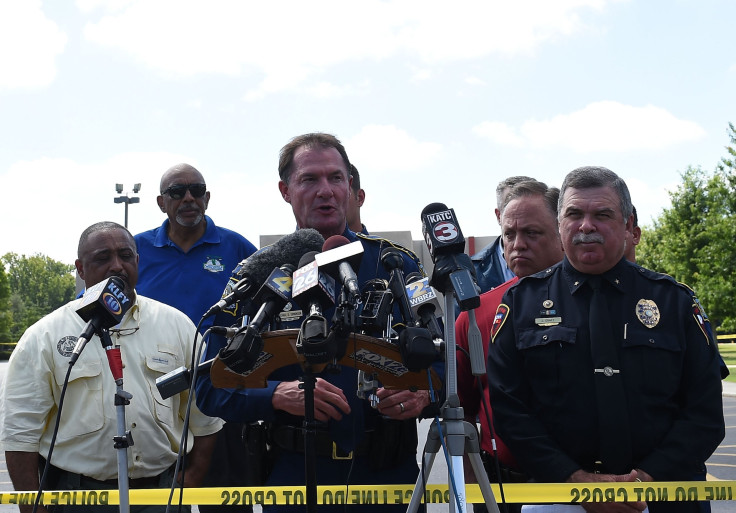Lafayette vs. Chattanooga: White 'Drifter' Gets Very Different Media Narrative Than Muslim 'Jihadist'

Two disturbed gunmen. Two very different media narratives.
Exactly one week after a gunman killed five service members in Chattanooga, Tennessee, another single shooter wreaked havoc on a movie theater in Lafayette, Louisiana, killing two people and then himself.
In both cases, motives are unknown. Yet in the absence of facts, two very different narratives were constructed by the media and in public statements by law enforcement officials: one for a Muslim who'd traveled in the last year to Jordan, and quite another for a middle-aged white man, immediately dubbed a "drifter."
“We look at white suspects as individuals, describing them in ways that are not connected to racially coded words and terminology," said Deepa Iyer, a senior fellow at the Center for Social Inclusion. "For people of color, we have a completely different set of narratives and descriptions.”
"Lone white male" Not a thug. Not a terrorist. Not part of a larger societal problem. Just one guy. Oh, and mental illness! #Lafayette
— D (@Delo_Taylor) July 24, 2015After Chattanooga, the shooter, Mohammod Youssuf Abdulazeez, was quickly revealed to have a Muslim-sounding name -- and both the media and law enforcement pounced on a potential terrorism connection. Fox News spent much of its airtime the day of the shooting falsely linking Abdulazeez to the Islamic State group -- a connection the FBI has yet to make. On CNN, before much was known about the shooter, one anchor wondered whether Abdulazeez was radicalized in the same way the Boston Marathon bomber was. The New York Daily News ran an early story with the headline, “Smiling Jihadi Kills 4 Marines.”
Police: The #Lafayette movie theater shooter was a white male in his 50’s. Latest on @CNN: http://t.co/YZ32bCT35k pic.twitter.com/95ANbtmRe9
— Anderson Cooper 360° (@AC360) July 24, 2015Yet after Lafayette, police described the shooter, John Russell Houser, as a “lone white male.” At a news conference Friday morning, Louisana State Police Col. Michael Edmonson listed some of Houser’s background -- such as his history of mental health problems, a background expressing radical views on conservative media sites and that he was a “drifter."
While law enforcement and the media seem, at times, to strain to connect Abdulazeez to a bigger motive or plot, they immediately threw up their hands on Houser. "We’re putting these things together ... to find some closure," Edmonson said. "We may not find a motive.”
Responses like Edmonson’s have prompted many to note how white shooters are individualized and spared the use of more coded descriptors like “thug.” Both Abdulazeez and Houser had a history of mental health issues, yet the same standard is not applied to each when searching for a motive.
On Twitter, a new account called @lonewhitemale and corresponding hashtag #lonewhitemale created late Thursday night after the Lafayette incident aims to highlight the double standard.
Will media and law enforcement see the #Lafayette shooting as an act of domestic terrorism? Probably not, because shooter was #lonewhitemale
— Lone White Male (@lonewhitemale) July 24, 2015Because #Lafayette shooter is #lonewhitemale, we won't hear words like thug, terrorist, criminal, foreigner. It will be "lone wolf" instead
— Lone White Male (@lonewhitemale) July 24, 2015#lonewhitemale is always sick & going through some hard times. Black folks & Moslems, u aren't allowed to be mentally ill or mad. #Lafayette
— Lone White Male (@lonewhitemale) July 24, 2015Others highlighted a recent report that showed more Americans have been killed by homegrown extremists in the U.S. than by so-called jihadists.
Bringing this back because y'all seem to be in denial #lonewhitemale http://t.co/q2lNyuX6YV
— Sali (@Dumblockb) July 24, 2015According to a CNN report, Houser had created profiles on the website Tea Party Nation and left hundreds of messages on PoliticalForum.com espousing anti-government, anti-media views. But many noted that there Houser would not be called out as a representative of the tea party in the same way that minority groups are represented as stand-ins for the social and cultural groups to which they belong.
Another RW teaparty terrorist at work. SO I guess we villify all teapartiers just like muslims now, right? #lafayette http://t.co/XlzArtESLI
— Robert Dobalina (@Citizen401) July 24, 2015That’s the most dangerous aspect of the way the media responds to perpetrators who are not white, Iyer said.
“When the shooter happens to be a person of color, there is an immediate taint over the entire community that person belongs to. The entire community, whether it’s black, Muslim, South Asian, is expected to apologize and explain, on behalf of the suspect,” Iyer said. “What’s worse is that these characterizations have policy outcomes, like profiling, that affect people’s daily lives. There is a suspicison that everyone is a potential Abdulazeez.”
#lonewhitemale responsible for #Lafayette. Was #lonebrownmale responsible for #Chattanooga? Nope an entire religion & its people were _
— Jerome Jones (@Jer0mej0nes) July 24, 2015© Copyright IBTimes 2024. All rights reserved.





















